Skin culture induced psoriasis model
Drug Discovery Assay – reference number: B113
This experiment assesses whether test articles cause a reduction in inflammatory cytokine release in psoriasis compared with a control compound, for example, a ROR-ɣ inhibitor (systemic) or betamethasone (topical). It uses healthy skin punch biopsies which are induced to display a psoriasis phenotype using a cocktail that induces the Th17/IL-17 pathway. We then explore test article effect on the expression on inflammatory cytokines via ELISA and/or rtPCR.
| Assay Type: | Skin |
| Tissue: | Human Skin Biopsies (Healthy) |
| Target: |
TLR4/TLR2 Pathway/ Glucocorticoid receptors/ PDE4
|
| Control Compound: | Fluticasone/ Roflumilast |
| Study Type: | Ex vivo cultures |
| Functional Endpoint: | Cytokine release/ Gene Expression |
Testing Information
Introduction
The specific results that will be provided are on the anti-inflammatory effect of test articles across an induced psoriasis model using human fresh skin.
Test Article Requirements
Test article(s) to be provided by the Sponsor in storable aliquots at required test concentrations with information on diluent vehicle used. Stock solutions are prepared in deionized water unless otherwise requested. Sponsor to provide sufficient test article to run the entire study.
Suggested Testing
We suggest test conditions are assessed in triplet as a minimum.
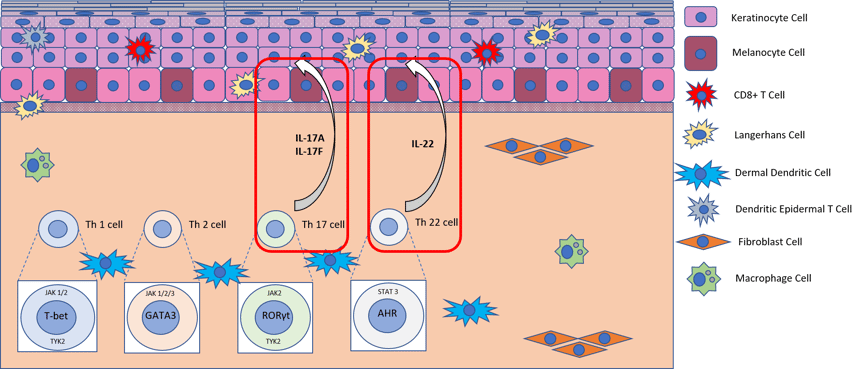
Diagram showing the cellular pathways activated by our psoriasis cocktail
Study Outline: Rationale and Experimental Design
Option 1: Systemic administration of test article
Full-thickness skin biopsies are achieved via punch-biopsy of residual surgical tissue. Biopsies are taken at a size of 3mm2 and transferred onto a mesh transwell in a 12 well plate. The dermis of the skin is submerged in specially fortified media, leaving the epidermis exposed to air. Biopsies are incubated in optimum conditions for a maximum of 24 hrs, then cultured in the presence of the inflammatory cocktail and the test article for a further 24 hrs. Tissue media is collected for phenotype analysis by ELISA and/or the biopsy set is collected for rtPCR.
An example of the conditions assessed for 3 test articles are detailed below (it is recommended a minimum of triplicates should be used for each condition):
- Non-stimulated control
- Stimulated control
- Test article 1
- Test article 2
- Test article 3
- Positive control
Option 2: Topical application of test article
Full-thickness skin biopsies are achieved via punch-biopsy of residual surgical tissue. Biopsies are taken at a size of 8mm2 and transferred onto a mesh transwell in a 12 well plate. The dermis of the skin is submerged in specially fortified media, leaving the epidermis exposed to air. Biopsies are incubated in optimum conditions for a maximum of 24 hrs, then cultured in the presence of the inflammatory cocktail (added to the media) and the test article (added to the exposed skin surface) for a further 24 hrs. Tissue media is collected for phenotype analysis by ELISA and/or the biopsy set is collected for rtPCR.
An example of the conditions assessed for 3 test articles are detailed below (it is recommended a minimum of triplicates should be used for each condition):
- Non-stimulated control
- Stimulated control
- Test article 1
- Test article 2
- Test article 3
- Positive control
Exclusion Criteria
No specific exclusion criteria are in place other than to reject macroscopically diseased/necrotic tissue.
Standardization and Qualification
Tissue that does not respond to stimulation with our TH17 inflammatory cocktail LPS would be deemed non-functional.
Analysis
Cytokine analysis: Supernatant samples can be analyzed for specific analytes of your choice by a multiplex ELISA platform. Each analyte will be quantified by interpolation against a standard curve generated on the same 96 well analysis plate.
Other forms of end point analysis are available such as gene expression or immunohistochemistry.
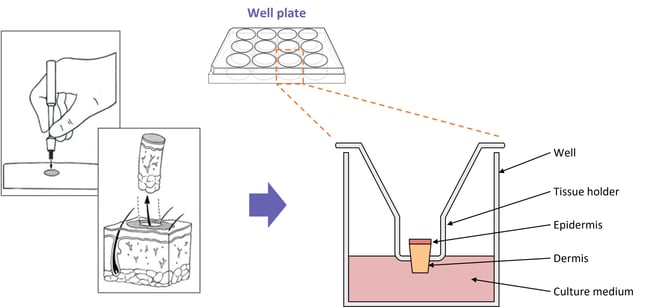
Diagram showing a typical setup for our skin disease explant assays
Case study: Induced-Psoriasis Model (Th17)
After stimulation of the Th17 pathway, the inhibition of inflammation by potential new drugs is assessed by determining the release of cytokines such as IL-17 or IL-22 using a Luminex assay. The example data below shows the inhibition of inflammation by the standard of care compound, calcipotriol. The data from diseased tissues thus complements the information from the healthy human tissue systems and provides the researcher with translational models to answer many drug discovery questions.
Our Th17 model has been used in numerous studies by clients in the pharmaceutical industry to help better predict the activity of new compounds in a human test system. For an example of a recent client-led project please make an inquiry.
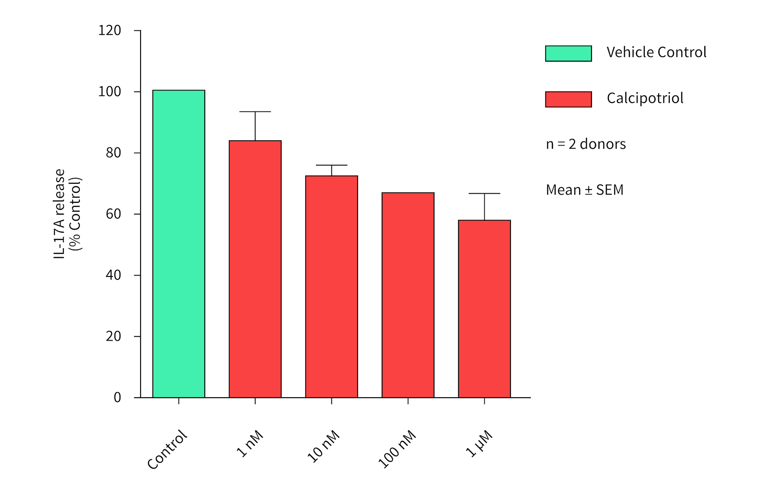
More example data from the Induced-Psoriasis model
Induction of IL-17A gene expression and secretion (systemic)
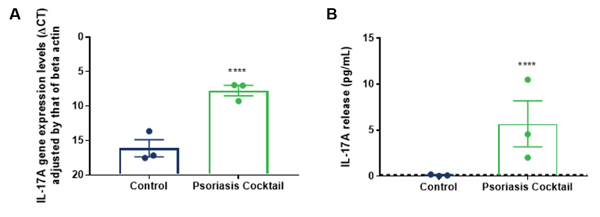 Data is presented as mean ± SEM in bar format with the individual donor means presented in the scatter. Analysis was conducted by two-way ANOVA. Three subjects were evaluated in quadruplicate measurements. Asterisks indicate significant (P < 0.05, for one, P < 0.01 for two, P < 0.001 for three and P < 0.0001 for four) differences versus the control group. Multiple comparisons across all test cocktails were evaluated with the Tukey test. A, Actin gene expression was used as the endogenous control and expression levels are therefore adjusted by those of actin using the ΔCT method. ; B, Dotted line represents the LLOQ of the ELISA.
Data is presented as mean ± SEM in bar format with the individual donor means presented in the scatter. Analysis was conducted by two-way ANOVA. Three subjects were evaluated in quadruplicate measurements. Asterisks indicate significant (P < 0.05, for one, P < 0.01 for two, P < 0.001 for three and P < 0.0001 for four) differences versus the control group. Multiple comparisons across all test cocktails were evaluated with the Tukey test. A, Actin gene expression was used as the endogenous control and expression levels are therefore adjusted by those of actin using the ΔCT method. ; B, Dotted line represents the LLOQ of the ELISA.
Inhibition of TH17 cell differentiation by RORγ inhibitor (systemic)
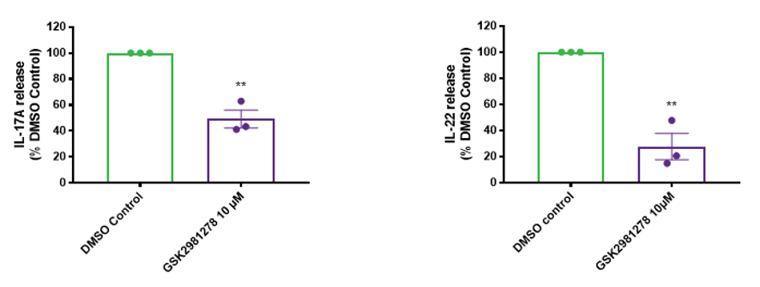 Data is presented as mean ± SEM. Analysis was conducted by two-tailed unpaired t-test. Three subjects were evaluated in quadruplicate measurements. Asterisks indicate significant (P < 0.05, for one, P < 0.01 for two, P < 0.001 for three and P < 0.0001 for four) differences versus the DMSO control group.
Data is presented as mean ± SEM. Analysis was conducted by two-tailed unpaired t-test. Three subjects were evaluated in quadruplicate measurements. Asterisks indicate significant (P < 0.05, for one, P < 0.01 for two, P < 0.001 for three and P < 0.0001 for four) differences versus the DMSO control group.
Results from topical application of SOC formulations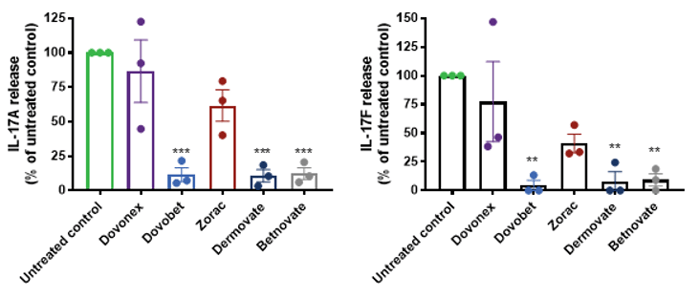
Data is presented as mean ± SEM in bar format with the individual donor means presented in the scatter. Analysis was conducted by two-way ANOVA . Three subjects were evaluated in quadruplicate measurements. Multiple comparisons were evaluated with the Dunnett’s test. Asterisks indicate significant (P < 0.05, for one, P < 0.01 for two, P < 0.001 for three and P < 0.0001 for four) differences versus the untreated control group.

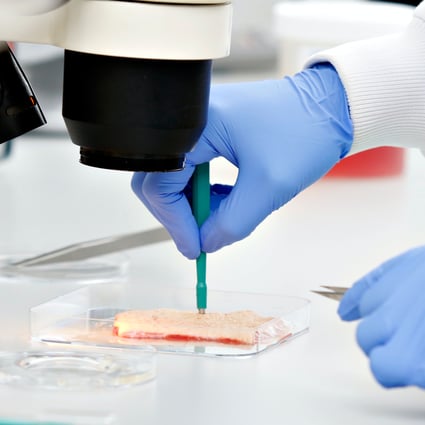



![Wire myography: the ultimate guide [protocol included]](https://www.reprocell.com/hs-fs/hubfs/REPROCELL-04.06.18_0163.jpg?width=756&height=425&name=REPROCELL-04.06.18_0163.jpg)